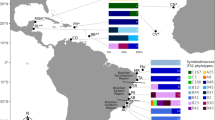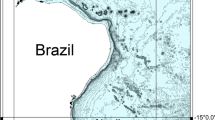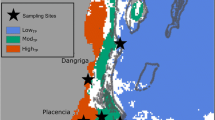Abstract
Shallow water reef-building corals associate with photosynthesizing dinoflagellates (Symbiodinium spp.) that may affect growth and resilience of their hosts. Understanding host–symbiont associations is critical for assessing the susceptibility of corals to climatic changes. Despite that, the diversity of Symbiodinium associated with corals from the Southwestern Atlantic Ocean is poorly known. Here, we describe diversity across major Symbiodinium clades associated with colonies of the endemic reef-building coral Mussismilia hispida (Verrill, 1902) along the Brazilian coast. By analyzing the 18S rDNA gene, we found that M. hispida associates with three clades of Symbiodinium (A, B and C). Moreover, the geographic distribution of host–symbiont associations is related to temperature and turbidity and closely follows previously recognized reef regions along the Brazilian coast. These results suggest that similar ecological processes are likely shaping both the reef communities and the host–symbiont associations over M. hispida distribution along the coast. Our study provides an advance in the understanding of symbiont diversity in a key reef-building coral. In addition, it contributes new insights for future investigations aiming at comprehending the factors determining Symbiodinium geographic distribution.



Similar content being viewed by others
References
Baker AC (2003) Flexibility and specificity in coral-algal symbiosis: diversity, ecology, and biogeography of Symbiodinium. Annu Rev Ecol Evol Syst 34:661–689
Baker AC, Rowan R, Knowlton N (1997) Symbiosis ecology of two Caribbean acroporid corals. Proc 8th Int Coral Reef Symp 2:1295–1300
Baker AC, Glynn PW, Riegl B (2008) Climate change and coral reef bleaching: an ecological assessment of long-term impacts, recovery trends and future outlook. Estuar Coast Shelf Sci 80:435–471
Banaszak AT, LaJeunesse TC, Trench RK (2000) The synthesis of mycosporine-like amino acids (MAAs) by cultured, symbiotic dinoflagellates. J Exp Mar Biol Ecol 249:219–233
Berkelmans R, Van Oppen MJH (2006) The role of zooxanthellae in the thermal tolerance of corals: a “nugget of hope” for coral reefs in an era of climate change. Proc R Soc B 273:2305–2312
Blackall LL, Wilson B, van Oppen MJH (2015) Coral—the world's most diverse symbiotic ecosystem. Mol Ecol 24:5330–5347
Bongaerts P, Riginos C, Ridgway T, Sampayo EM, van Oppen MJH, Englebert N, Vermeulen F, Hoegh-Guldberg O (2010) Genetic divergence across habitats in the widespread coral Seriatopora hystrix and its associated Symbiodinium. PLoS One 5:e10871
Borcard D, Gillet F, Legendre P (2011) Numerical ecology with R. Springer, New York
Budd AF, Fukami H, Smith ND, Knowlton N (2012) Taxonomic classification of the reef coral family Mussidae (Cnidaria: Anthozoa: Scleractinia). Zool J Linn Soc 166:465–529
Caldeira K (2013) Coral “refugia” amid heating seas. Nat Clim Change 3:444–445
Castro CB, Pires DO (2001) Brazilian coral reefs: what we already know and what is still missing. Bull Mar Sci 69:357–371
Castro CB, Segal B, Negrão F, Calderon EN (2012) Four-year monthly sediment deposition on turbid southwestern Atlantic coral reefs, with a comparison of benthic assemblages. Braz J Oceanogr 60:49–63
Chan YL, Pochon X, Fisher MA, Wagner D, Concepcion GT, Kahng SE, Toonen RJ, Gates RD (2009) Generalist dinoflagellate endosymbionts and host genotype diversity detected from mesophotic (67–100 m depths) coral Leptoseris. BMC Ecol 9:1–7
Coffroth MA, Santos SR (2005) Genetic diversity of symbiotic dinoflagellates in the genus Symbiodinium. Protist 156:19–34
Coffroth MA, Santos SR, Goulet TL (2001) Early ontogenetic expression of specificity in a cnidarian-algal symbiosis. Mar Ecol Prog Ser 222:85–96
Cooper TF, Berkelmans R, Ulstrup KE, Weeks S, Radford B, Jones AM, Doyle J, Canto M, O’Leary RA, van Oppen MJH (2011) Environmental factors controlling the distribution of Symbiodinium harboured by the coral Acropora millepora on the Great Barrier Reef. PLoS One 6:e25536
Core Team R (2015) R: a language and environment for statistical computing. R Foundation for Statistical Computing, Vienna
Costa CF, Sassi R, Gorlach-Lira K (2008) Zooxanthellae genotypes in the coral Siderastrea stellata from coastal reefs in northeastern Brazil. J Exp Mar Biol Ecol 367:149–152
Cunning R, Baker AC (2012) Excess algal symbionts increase the susceptibility of reef corals to bleaching. Nat Clim Change 2:1–4
Ekau W, Knoppers B (1999) An introduction to the pelagic system of the Northeast and East Brazilian shelf. Arch Fish Mar Res 47:5–24
Frade PR, De Jongh F, Vermeulen F, van Bleijswijk J, Bak RPM (2008) Variation in symbiont distribution between closely related coral species over large depth ranges. Mol Ecol 17:691–703
Frieler K, Meinshausen M, Golly A, Mengel M, Lebek K, Donner SD, Hoegh-Guldberg O (2013) Limiting global warming to 2 °C is unlikely to save most coral reefs. Nat Clim Change 3:165–170
Fukami H, Budd AF, Paulay G, Solé-Cava AM, Chen CA, Iwao K, Knowlton N (2004) Conventional taxonomy obscures deep divergence between Pacific and Atlantic corals. Nature 427:832–835
Garren M, Walsh SM, Caccone A, Knowlton N (2006) Patterns of association between Symbiodinium and members of the Montastraea annularis species complex on spatial scales ranging from within colonies to between geographic regions. Coral Reefs 25:503–512
Hoegh-Guldberg O (1999) Climate change, coral bleaching and the future of the world’ s coral reefs. Mar Freshw Res 50:839–866
Howells EJ, Beltran VH, Larsen NW, Bay LK, Willis BL, van Oppen MJH (2012) Coral thermal tolerance shaped by local adaptation of photosymbionts. Nat Clim Change 2:116–120
Jokiel PL, Brown EK (2004) Global warming, regional trends and inshore environmental conditions influence coral bleaching in Hawaii. Glob Change Biol 10:1627–1641
Jones AM, Berkelmans R (2011) Tradeoffs to thermal acclimation: energetics and reproduction of a reef coral with heat tolerant Symbiodinium type-D. J Mar Biol 2011:1–12
Knowlton N, Rohwer F (2003) Multispecies microbial mutualisms on coral reefs: the host as an habitat. Am Nat 162:S51–S62
Laborel J (1970) Leus peuplements de Madreporaires des cotes tropicales du Bresil. Ann. L’Université D’Abidjan Série EII:1–261
LaJeunesse TC (2002) Diversity and community structure of symbiotic dinoflagellates from Caribbean coral reefs. Mar Biol 141:387–400
LaJeunesse TC (2005) “Species” radiations of symbiotic dinoflagellates in the Atlantic and Indo-Pacific since the Miocene-Pliocene transition. Mol Biol Evol 22:570–581
LaJeunesse TC, Loh WKW, Van Woesik R, Hoegh-guldberg O, Schmidt GW, Fitt WK (2003) Low symbiont diversity in southern Great Barrier Reef corals, relative to those of the Caribbean. Limnol Oceanogr 48:2046–2054
Leão ZMAN, Kikuchi RKP, Testa V (2003) Corals and coral reefs of Brazil. In: Cortés J (ed) Latin American Coral Reefs. Elsevier Science B.V, Amsterdam, pp 9–52
Legendre P, Anderson MJ (1999) Distance-based redundancy analysis: testing multispecies responses in multifactorial ecological experiments. Ecol Monogr 69:1–24
Loh W, Carter D, Hoegh-Guldberg O (1998) Diversity of zooxanthellae from scleractinian corals of One Tree Island (The Great Barrier Reef). Australian Coral Reef Society 75th Anniversary Conference, Heron Island, Australia, pp 141–151
Loh WKW, Loi T, Carter D, Hoegh-guldberg O (2001) Genetic variability of the symbiotic dinoflagellates from the wide ranging coral species Seriatopora hystrix and Acropora longicyathus in the Indo-West Pacific. Mar Ecol Prog Ser 222:97–107
Maida M, Ferreira B (1997) Coral reefs of Brazil: an overview. In: Proc. 8th Int. Coral Reef Symp. 1:263–274
Mieog JC, van Oppen MJH, Cantin NE, Stam WT, Olsen JL (2007) Real-time PCR reveals a high incidence of Symbiodinium clade D at low levels in four scleractinian corals across the Great Barrier Reef: implications for symbiont shuffling. Coral Reefs 26:449–457
Minh BQ, Nguyen MAT, von Haeseler A (2013) Ultrafast approximation for phylogenetic bootstrap. Mol Biol Evol 30:1188–1195
Monteiro JG, Costa CF, Gorlach-Lira K, Fitt WK, Stefanni SS, Sassi R, Santos RS, LaJeunesse TC (2013) Ecological and biogeographic implications of Siderastrea symbiotic relationship with Symbiodinium sp. C46 in Sal Island (Cape Verde, East Atlantic Ocean). Mar Biodivers 43:261–272
Muller J, Creevey CJ, Thompson JD, Arendt D, Bork P (2010) AQUA: automated quality improvement for multiple sequence alignments. Bioinformatics 26:263–265
Nguyen LT, Schmidt HA, von Haeseler A, Minh BQ (2015) IQ-TREE: a fast and effective stochastic algorithm for estimating maximum likelihood phylogenies. Mol Biol Evol 32:268–274
Oksanen J, Blanchet FG, Kindt R, Legendre P, Michin PR, O’Hara RB, Simpson GL, Solymos P, Stevens HH, Wagner H (2015) vegan: community ecology package. R-package version 2.3-2. https://cran.r-project.org/web/packages/vegan/index.html
Oliver TA, Palumbi SR (2011) Many corals host thermally resistant symbionts in high-temperature habitat. Coral Reefs 30:241–250
Pochon X, Gates RD (2010) A new Symbiodinium clade (Dinophyceae) from soritid foraminifera in Hawai’i. Mol Phylogenet Evol 56:492–497
Pochon X, Pawlowski J (2006) Evolution of the soritids-Symbiodinium symbiosis. Symbiosis 42:77–88
Rodriguez-Lanetty M, Loh W, Carter D, Hoegh-Guldberg O (2001) Latitudinal variability in symbiont specificity within the widespread scleractinian coral Plesiastrea versipora. Mar Biol 138:1175–1181
Rogers CS (1990) Responses of coral reefs and reef organisms to sedimentation. Mar Ecol Prog Ser 62:185–202
Rowan R, Powers DA (1991a) A molecular genetic classification of zooxanthellae and the evolution of animal-algal symbioses. Science 251:1348–1351
Rowan R, Powers DA (1991b) Molecular genetic identification of symbiotic dinoflagellates (zooxanthellae). Mar Ecol Prog Ser Oldend 71:65–73
Rowan R, Knowlton N, Baker A, Jara J (1997) Landscape ecology of algal symbionts creates variation in episodes of coral bleaching. Nature 388:265–269
Silva-Lima AW, Walter JM, Garcia GD, Ramires N, Ank G, Meirelles PM, Nobrega AF, Silva-Neto ID, Moura RL, Salomon PS, Thompson CC, Thompson FL (2015) Multiple Symbiodinium strains are hosted by the Brazilian endemic corals Mussismilia spp. Microb Ecol 70:301–310
Silverstein RN, Correa AMS, Baker AC (2012) Specificity is rarely absolute in coral-algal symbiosis: implications for coral response to climate change. Proc R Soc B 279:2609–2618
Soares MDO, Paiva CC, Eduardo J, Freitas P, Monteiro T (2011) Gestão de unidades de conservação marinhas: o caso do Parque Estadual Marinho da Pedra da Risca do Meio, NE–Brasil. Rev da Gestão Costeira Integr 11:257–268
Spalding MD, Fox HE, Allen GR, Davidson N, Ferdaña ZA, Finlayson MAX, Halpern BS, Jorge MA, Lombana AL, Lourie SA, Martin KD, Manus MC, Molnar J, Recchia CA, Robertson J (2007) Marine ecoregions of the world: a bioregionalization of coastal and shelf areas. BioSci 57:573–583
Stat M, Bird CE, Pochon X, Chasqui L, Chauka LJ, Concepcion GT, Logan D, Takabayashi M, Toonen RJ, Gates RD (2011) Variation in Symbiodinium ITS2 sequence assemblages among coral colonies. PLoS One 6:e15854
Sullivan-Sealey K, Bustamante G (1999) Setting geographic priorities for marine conservation in the Latin America and the Caribbean. The Nature Conservancy, Arlington
Tonk L, Sampayo EM, Weeks S, Magno-Canto M, Hoegh-Guldberg O (2013) Host-specific interactions with environmental factors shape the distribution of Symbiodinium across the Great Barrier Reef. PLoS One 8:e68533
Ulstrup KE, Van Oppen MJH (2003) Geographic and habitat partitioning of genetically distinct zooxanthellae (Symbiodinium) in Acropora corals on the Great Barrier Reef. Mol Ecol 12:3477–3484
Valentin J (2001) The Cabo Frio upwelling system, Brazil. In: Seeliger U, Kjerfve B (eds) Ecological studies, vol 144., Coastal marine ecosystems of Latin AmericaSpringer, Berlin, pp 97–105
Van Oppen MJ, Palstra FP, Piquet AM, Miller DJ (2001) Patterns of coral-dinoflagellate associations in Acropora: significance of local availability and physiology of Symbiodinium strains and host-symbiont selectivity. Proc R Soc B 268:1759–1767
Van Oppen MJH, Mahiny AJ, Done TJ (2005) Geographic distribution of zooxanthella types in three coral species on the Great Barrier Reef sampled after the 2002 bleaching event. Coral Reefs 24:482–487
van Oppen MJH, Baker AC, Coffroth MA, Willis BL (2009) Bleaching resistance and the role of algal endosymbionts. In: van Oppen MJH, Lough J (eds) Coral bleaching: patterns, processes, causes and consequences, Ecological Studies 205. Springer, Berlin, pp 83–102
Wagner D, Pochon X, Irwin L, Toonen RJ, Gates RD (2011) Azooxanthellate? Most Hawaiian black corals contain Symbiodinium. Proc R Soc B 278:1323–1328
Weis VM (2010) The susceptibility and resilience of corals to thermal stress: adaptation, acclimatization or both? Mol Ecol 19:1515–1517
Wicks LC, Gardner JPA, Davy SK (2012) Host tolerance, not symbiont tolerance, determines the distribution of coral species in relation to their environment at a Central Pacific atoll. Coral Reefs 31:389–398
Acknowledgments
We thank Dr. A. M. Solé-Cava (UFRJ) and Dr. M. Klautau (UFRJ) for laboratory facilities. Thomas Bell (UCSB) provided helpful assistance with compilation of MODIS-Aqua data. Dr. M. Warner (UD) generously supplied DNA extracts of Symbiodinium cultures. Dr. E. Calderon (Coral Vivo/MNRJ), C. Pereira (Coral Vivo), L. Lopes (Coral Vivo), A. Climério, J. Medeiros (CEBIMar), E. Honuma (CEBIMar) and J. Sebroeck (in memoriam, CEBIMar) provided assistance in field collections. Dr. T. Oakley (UCSB), colleagues of the Evolution Seminar (EV595/UCSB), L. Lima (IEAPM) and V. Tascheri (UFRJ) contributed with insightful comments on early versions of the manuscript. We thank the Brazilian Marine Biodiversity Network SISBIOTA-Mar (CNPq 563276/2010-0 and FAPESC 6308/2011-8, PI: S.R. Floeter) for collection of samples at PML, FZ, TE, SA, AR, FN and TR. Project BIOTA (FAPERJ E-26/110.015/2011, PI: PC Paiva), particularly, Dr. R. Ventura and Dr. F. Pitombo for collecting at IG, A. Garrido and L. Peluso for sampling in GP and Dr. F. Nunes for the JP samples. We also thank the Coral Vivo Research Network, sponsored by Petrobras through the program Petrobras Socioenvironmental and co-sponsored by Arraial D’Ajuda EcoParque, for financial and logistical support for field work, and Conselho Nacional de Desenvolvimento Científico e Tecnológico (CNPq) for a master fellowship to NP (process 130913/2011-1) and a research fellowship to PCP (process 303939/2014-1). We are thankful to the NASA Ocean Biology Processing Group for production and distribution of MODIS-Aqua satellite data.
Author information
Authors and Affiliations
Corresponding author
Ethics declarations
Conflict of interest
The authors declare no conflict of interest relevant to the subject of this article.
Animal rights statement
Animals have been sampled and/or treated according to the national legislation, and all required permissions have been obtained.
Additional information
Responsible Editor: S. Uticke.
Reviewed by B. Hume and Undisclosed experts.
Electronic supplementary material
Below is the link to the electronic supplementary material.
Rights and permissions
About this article
Cite this article
Picciani, N., de Lossio e Seiblitz, I.G., de Paiva, P.C. et al. Geographic patterns of Symbiodinium diversity associated with the coral Mussismilia hispida (Cnidaria, Scleractinia) correlate with major reef regions in the Southwestern Atlantic Ocean. Mar Biol 163, 236 (2016). https://doi.org/10.1007/s00227-016-3010-z
Received:
Accepted:
Published:
DOI: https://doi.org/10.1007/s00227-016-3010-z




